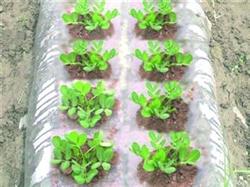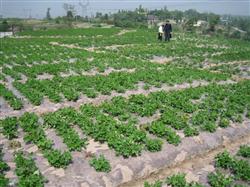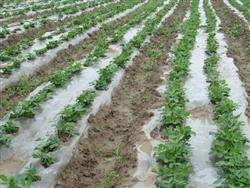Eight points for attention in plastic Film mulching cultivation of Spring Peanut

The application of plastic film mulching cultivation technology in peanut production can play the role of increasing temperature, preserving whole seedlings, preserving water and fertilizer, so as to achieve the purpose of increasing yield, increasing income and striving for seasonal initiative. The comparative experiment of spring peanut cultivation with plastic film mulching was carried out in 2002, and the yield per mu was 402.7 5 kg in plot experiment and 367.5 kg in field, which was more than 50 kg higher than that in bare land. In this paper, several main problems that should be paid attention to in peanut plastic film mulching cultivation are summarized as follows for your reference. The ground temperature of spring peanut can be increased by 3-4 ℃ after plastic film mulching, and the soil temperature in the range of 5-10 cm can reach 12-13 ℃ 10 days before the final frost period, and the sowing time can be advanced about 10 days. Therefore, it is required that in the first winter, after ploughing and bleaching, the planting land should be raked many times to make the soil broken, and then straighten the bed according to the width of the plastic film, the border surface should be flat, and the soil should be finely broken to ensure the quality of the plastic film. The planting time can be carried out 10-12 days before the local final frost period, and sowing in northern Guangdong in late February, but the effect of film mulching is not obvious when sowing too late. The fertilizer utilization rate of mulching planting is high, and the plant growth is exuberant, and the planting density should be determined according to the characteristics of the variety and soil fertility. The specification can be 20 cm × 26 cm or 23 cm × 26 cm, sowing 0.95-1.0 thousand holes per mu and two seeds per hole. Cover the film immediately after planting, and consider that the white film of 0.015-0.018 mm can be selected for convenience in cutting the film and increasing temperature. It is difficult for the fruit needle to penetrate the film into the soil when it is more than 0.02 mm. In order to save the cost, you can also choose a disposable white transparent ultrathin film, which requires the film to be close to the soil surface, leaving no space, and pressed around with soil. Mulching cultivation is not middle ploughing, no topdressing, at the same time, the soil temperature increases, the activity of microorganisms increases, and the organic matter in the soil decomposes quickly, so it is necessary to increase the application rate of organic fertilizer. 1000-1500 kg of mature manure per mu can be mixed with 50 kg of high concentration compound fertilizer, or 100kg of peanut special compound fertilizer, 1 kg of borax combined with the first rake field application as base fertilizer. In the later stage of growth, 0.2% urea solution combined with potassium dihydrogen phosphate and trace elements can be used for foliar spraying according to the growth and development of the plant supplemented with foliar fertilization. Pre-bud herbicides can be sprayed with 50% butachlor (or 50% Acetochlor) 100-150 ml or 72% dull 100 ml per mu after sowing, such as weeds that can be mixed with appropriate amount of germicidal herbicides (glyphosate, Roundup, gram) to kill weeds. The dosage of herbicide before bud should not be too much, otherwise the leaves of seedlings will be curled and yellowed, the root system will be thin and weak, and the root nodule will be small and small, which will seriously affect the growth of the plant. Because it is difficult for Rain Water to replenish water in the soil after plastic film mulching, if the soil is too dry, there will be dry seeds, slow emergence, uneven growth and lack of seedlings, but if the water content is too high, it will be due to poor soil permeability. Seed breathing is not smooth, resulting in braised seeds, rotten seeds and lack of seedlings. When sowing, the suitable humidity of the soil is to hold the soil in a clump, and it is appropriate to loosen it. If there is a cloudy day in the growing season, it is necessary to clear the ditch and drain in time to prevent the spread of rotten roots, rotten fruits and plant diseases; ditch irrigation should be used for irrigation during drought (no flooding irrigation). After mulching, the temperature under the film is as high as 50 ℃ in sunny days. When cotyledons break through the surface soil 7-10 days after sowing, the seedlings should be cut in time to prevent the seedlings from being burned or roasted to death, and the first pair of lateral branches should be ensured. The time of film cutting should be controlled before the third real leaf is unfolded after the cotyledon arch breaks the topsoil, and the earlier the better. The method is to gently cut a small opening in the unearthed cotyledons with a blade to draw out the seedlings. If the cut is too large, apply clods around to press to ensure the effect of film mulching. The peanut plants cultivated with plastic film mulching grow vigorously and have strong resistance to bacteria, but due to the increase of ground temperature after plastic film mulching, the activity time of underground pests (ground tiger, mole cricket, etc.) will be advanced accordingly, and the activity of rhizosphere bacteria will also be enhanced. when spraying pesticides, the pests will hide under the film, which brings some difficulty to the control work. In the prevention and control, it should be considered to mix seeds with methyl topiramate, sprinkle granule pesticides (carbofuran, methyl willow phosphorus, etc.) in the planting ditch, and select internal inhalation, contact and stomach poison pesticides or biological pesticides for prevention and control. The growth and development of peanut cultivated with plastic film mulching is accelerated, and the phenomenon of overgrowth and lodging is easy to occur in the later stage, which affects the yield. The seedlings should be controlled in time 20-25 days after the first flowering (12-13 leaves of the main stem of pearl bean peanut). You can choose b9 pesticide 800 ppm or 15% paclobutrazol with 50 grams of water and 50 kilograms per mu to spray to control seedlings. The mature period of peanut cultivation through plastic film mulching can be 7-10 days in advance. If the peanut is not harvested in time, the yield will be affected by falling fruit or sprouting in the soil, the lower leaves should fall off, the upper leaves should turn yellow, and the sunny day should be harvested when the liquid movement of the leaves disappears; plastic film should be recovered and concentrated after harvest so as not to affect the growth of crops and cause environmental pollution.
- Prev

Cultivation techniques of Spring Peanut covered with plastic Film
The plastic film mulching cultivation technology of spring peanut was popularized in Anxi county, the general yield was 15% higher than that of open field cultivation under similar conditions, the aspergillus flavus was reduced, the quality of peanut was improved, and good benefits were obtained. Its cultivation techniques are as follows: first, the selection of varieties with strong disease resistance, good waterlogging tolerance, suitable for fertilizer and water.
- Next

Technology of plastic Film mulching in large area of Spring Peanut to increase yield by soil moisture and dry sowing
Plastic film mulching for fruit sowing is an effective measure to protect the whole seedling, resist drought and increase yield of spring peanut by early sowing. Linmu County Agricultural Technology extension Center began to experiment and demonstrate in 1987. From 1992 to 1993, the implementation area reached 8520 hectares, with an average yield of 3982.5 kg / ha and 4057.5 kg / ha, an increase of 13.9% and 16%.
Related
- The first cup of black tea in spring, the flavor and history of tea gardens in Kenya, Africa
- The computer can not only choose potatoes, but also grow tea rice. AI will grow winter oolong tea champion.
- It is not only the inflated tea bitten by insects, but also engraved with the four seasons tea in Beipu.
- The Oriental Beauty Tea Festival in Zhuxian County takes the stage at the weekend to experience the plus-size feast of oil tea.
- & quot; Oriental Beauty Tea & Exploration of Emei in Hsinchu, the hometown of quot;
- The new variety of strawberry "Tainong 1" dessert is the first choice with mellow aroma. Crimson gorgeous
- History of Tea in Taiwan: from Wild Inner Mountain to Export Tea Garden
- Two types of Taiwan Oriental Beauty Black Tea won the British three-Star Award for Childhood Tea Xiang Zhang Jiaqi changed from pilot to champion tea maker.
- Banana species and varieties: the planting history of Taiwan Xianren banana and dwarf banana is long, is banana disease resistant?
- Coffee planting Technology: Qianjie Coffee from Seedling to harvesting

